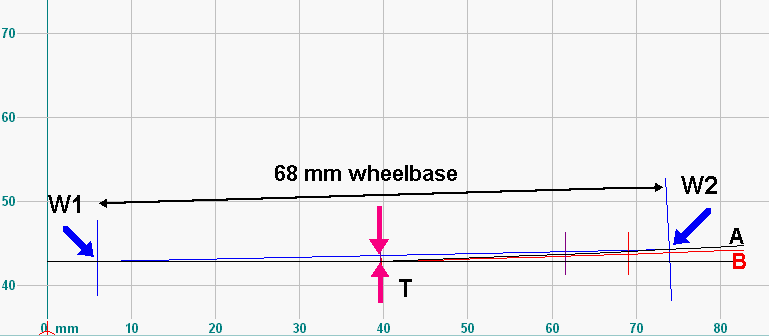| Templot Companion | search | remove search highlighting | if the A-Z Index tab is missing click here |
A or B switch ?
A technical article about choosing a size "A" or "B" switch for models.

This diagram shows the running edge of the left-hand stock rail of a left-hand switch. Black line A shows the stock rail running edge for a REA semi-curved size A switch, which has a deflection angle of 1:24 from the "toe" (blade tips). A "set" (bend) occurs in the stock rail at this point, marked T, the bend deflection angle corresponding to the planing angle on the switch blades. Red line B shows the stock rail running edge for a size B switch (deflection angle 1:32).
A 6-coupled steam locomotive having a wheelbase of 8'-6" + 8'-6" (34mm + 34mm in 4mm scale) is represented by the blue line W1-W2, having its outer driving wheels at W1 and W2, and its centre driving wheel at the switch toe T. This is usually the limiting condition.
For simplicity, if we ignore any freedom between the wheels and the track, and the effect of the switch curve beyond the end of the planing (these discrepancies work in opposition, i.e. tend to cancel), we can see that the sideplay (each way from a wheels-in-line condition) needed on the centre wheel in order to remain on the rail at T (pink arrows) is half of 34/24 mm for the A switch shown ( = 0.71 mm sideplay). If the wheel at W2 is moved onto the red line for switch B, the sideplay needed at T will be reduced, to half of 34/32 mm (= 0.53 mm sideplay).
If the sideplay is small in relation to the wheelbase (as is usually the case), the formula to find the corresponding effective radius is:
radius = halfwheelbase-squared, divided by centre-sideplay-doubled.
For the A switch, with sideplay needed of 0.71 mm and halfwheelbase of 34 mm, this gives
effective radius = 34^2 / ( 0.71*2 ) = 814 mm (32") approx.
For the B switch, with sideplay needed of 0.53 mm and halfwheelbase of 34 mm, this gives
effective radius = 34^2 / ( 0.53*2 ) = 1090 mm (43") approx.
This means that for a 4mm scale 6-coupled loco of 17ft wheelbase, to traverse an A switch requires an ability to run on a 32" radius curve. Traversing a B switch requires an ability to run on a 43" radius curve. (Note that these figures change for different wheelbases.)
There are several factors which have been ignored here for simplicity, but it is clear that the difference between an A and B switch is significant, and for P4 models the effective radius of an A switch is likely to be smaller than is generally advised for steam locomotives other than short wheelbase shunters.
Click for more about switches, deflection angles, etc.
Martin. © 17-Oct-2002
link to this page: https://85a.uk/templot/companion/a_or_b_switch.php